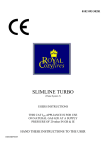Download North Wales Construction user guide
Transcript
North Wales Construction Framework User Guide 1 FAQ What do I need to do to use the Framework for my project? 1 Step 1- Register the project • Through Expression of Interest form if not a NW local authority, or Registration form and submit to Framework Manager Step 2- If NOT one of the NW local authorities 2 • Sign the Charter and Access Agreement. Contact Framework Manager for support. Step 3 – Prepare Mini Tender documents • Set up initial meeting with Framework Support Team (Framework Manager will help set up) • Set up project team to inform mini tender template • Complete the mini tender template 3 • Agree type of contract to be used • Set specific Quality questions (including Community Benefits, specific support available via Nina Ruddle, Value Wales) • Agree Q/P weighting (within Framework parameters) and scoring/ evaluation • Set project specifc KPIs (Framework KPIs are set already for each project) • Agree pricing approach depending on type of contract used • Agree interview questions and scoring if to be used • Agree timescale for return of mini tender (4-6 weeks depending on complexity) • Agree scoring and evaluation teams (ensure enough details recorded so that constructive feedback can be given to all Contractors. Set word limits to responses) Step 4- Send out mini tender to all Contractors in selected lot • Via e procurement route (proactis, bravo etc) if possible or; • Usual procurement route Step 5- Evaluate mini tenders in accordance with weighting • Benchmark selected tenders against schedule of rates submitted at Framework level for all Contractors • Interview if necessary and evaluate Quality questions • Agree successful contract through usual channels 2 4 5 Step 6- Appoint Contractor • Issue letters to successful and unsuccessful Contractors • Provide constructive and detailed feedback 6 • Issue contracts to successful contractor including contract clauses for Community Benefits, delivery, monitoring of KPIs and completion of the Community Benefits Measurement tool Step 7- Start up meeting with Contractor • Agree methods of operation • Agree targets and KPIs • Agree the Employment and Skills Plans with Contractors Step 8- Start on site • Monitor KPIs and report to Framework Manager • Manage contract and issues/ risk through the operational board and strategic board, if appropriate, share project data at operational board meetings 7 8 • Project management, attend SIG if appropriate Step 9- Completion, handover and post Construction Review • Case study and Review of KPI performance, post occupancy Review with clients 9 3 Contents 1. Executive Summary5 Purpose of this document 6 Benefits 2. The Framework Arrangement 6 7 Background 7 Aim, Vision and Objectives 7 Who can use the Framework? 8 Types of Work 8 Types of Project Delivery 9 Post Construction Services 10 Framework Lots 11 Contractor 11 Framework Management 12 Workshops and Training 12 How to appoint a contractor 14 Selection – Mini Tender 15 Design and Build Mini-Tender 16 Full design Mini-Tenders 16 Early Contractor Involvement 16 Novation 16 Principles 17 Data Management 17 Process 17 Fit to proceed to contractor appointment 17 End of Construction Review 18 People and customer satisfaction Review 18 Framework Performance Indicators 18 Frequency and method of collection 19 Value of KPIs and Review 19 Special Interest Groups 19 Annual Health check 19 Community Benefits Charter 20 1. List of Potential Future users of the Framework 22 2. Charter 3. Key Performance Indicators 3. Framework Operation13 4. Quality 5. Community Benefits Appendices22 4 24 25 4. Expression of Interest template 28 5. Registration Form 29 6. List of Abbreviations 30 1. Executive Summary The North Wales Schools and Public Buildings Contractor Framework (NWSPBCF) is part of a number of Collaboration Programmes between the six North Wales Authorities (Denbighshire County Council, Conwy County Borough Council, Flintshire County Council, Gwynedd Council, Wrexham County Borough Council, Ynys Mon County Council) to address the Programme for Wales’ priorities. It is the first generation of local authority-driven Construction Framework in North Wales and will serve as a catalyst for changing the way that Construction projects are procured in the region. The Framework has been established for the efficient delivery of the “21st Century Schools Programme” with an approximate combined value of £200 million. Delivering “Community Benefits” is at the heart of both the procurement approach and the coordination of the investment into the 21st Century Schools Programme, with a view to unlocking wider economic, social and environmental regeneration. There is a core set of Community Benefit principles which have been agreed by the six North Wales Authorities, who will each work in partnership with the successful Contractors to ensure that these are delivered. The Framework has been built on an ethos of openness and flexibility, achieved through continuous engagement and two way communications between the Authorities and Contractors / suppliers. The Framework may also be utilised by other public sector bodies across the region. List can be found at appendix 1. 5 Purpose of this document The purpose of this guide is to give clients a quick understanding of the Framework’s processes and ethos. To give a clear guidance of how the Framework should be used and the principles on which it will be managed. Participating authorities and other public sector bodies should develop their own individual working procedures that comply with their own contractual procedure rules and the Framework principles. Framework documentation is developed collaboratively by the Framework Management Team and the Operational Management Board. All Framework documentation will be subject to regular review and development and will be available electronically. Benefits There are a number of potential benefits to be achieved by using this Framework namely: • The Framework has already carried out a tender process which is fully compliant with UK and European Procurement Law - thereby saving you valuable time and resources with greatly reduced procurement timescales. There is no need to advertise the requirements and there are no minimum time periods within the process to which you must adhere. • The opportunity to have a forum for learning, developing and improving the way in which participating authorities and other public sector bodies deliver Construction projects, encouraging collaboration. • Contractors listed on the Framework agreement have already been assessed for their operational, technical and professional conformance and capabilities. • Pre-agreed terms and conditions are imbedded into the Framework agreement. • The Mini Tender procedure ensures that projects can get underway quickly and efficiently. • Framework support, with the monitoring of Contractors through KPIs, benchmarking against industry standards and encouraging continuous improvement. • Forums and special interest groups to encourage shared learning, skills and knowledge. • Innovative initiatives such as project bank accounts, BIM and National Construction Skills Academy. The Framework agreement will be centrally managed and monitored by Denbighshire County Council. Through the governance structure the benefits of the Framework will be monitored. An annual performance report will be produced to highlight progress against milestones and delivery of benefits. 6 2. The Framework Agreement Background The Framework is a collaborative project funded Welsh Government Department for Education and Skills. The implementation was led by Denbighshire and Flintshire County Councils on behalf of the 6 North Wales authorities. As part of the 21st Century Schools Programme one of the key requirements is that local authorities are to procure all proposed Construction works through a regional collaborative procurement approach hence the need to create a North Wales Framework. Alongside the regional Framework, the principles adopted through the Framework will be applied to projects valued below the OJEU threshold across the region. This will ensure consistency, drive delivery of the community benefits, develop continuous improvement and set new benchmarks for best practice. Aim, Vision and Objectives AIM: to provide a simple, cost effective, easy to use and transparent process to manage the delivery of the Schools Programme collaboratively in North Wales. VISION: the approach will be to partner with excellent Contractors who will engage positively with users and their consultants to provide Construction services that will deliver “Future Schools” and other public sector buildings, for value for money and for the benefit of local communities. OBJECTIVES: to contribute to the promotion of environmental, social and economic regeneration • successful completion of ambitious Projects • establishing of sound and stable relationships with Contractors • development of efficient, mutually beneficial working relationships • value for money and the reduction of costs maximising the efficiencies of scale, volume and certainty in imaginative and innovative ways • good quality design and innovative proposals that satisfy or exceed specified standards within established financial budgets • improvement of the quality of schools and service delivery • energy efficient to reduce carbon emissions, fuel costs and other life cycle benefits and also maximise the use of renewable energy measures • use of modern methods of Construction and innovative Construction techniques 7 • the promotion of compliance • sustainable approach • reduction of capital cost and whole life costs • reduction of design, supply and Construction time • reduction of defects and aim for zero defects in the Construction work • increase in predictability and productivity • the promotion and achievement of Community Benefits Who can use the Framework? In addition to the NW Authorities, other public bodies may access and use the Framework. A list of Authorities, public bodies and potential additional users is set out in Appendix 1. Types of Work It is anticipated that this Framework will be used to procure via mini tender a wide range of educationrelated Works under the Framework which may cover (but will not be limited to) the following educational facilities: • primary schools • secondary / high schools • sixth form / further education facilities • early years / nursery / day care facilities • special educational needs and learning facilities 8 Although the Framework will primarily be used in connection with the Schools Programme, users may also utilise the Framework to procure non-education Projects, which may cover the following local authority / public sector buildings and / or facilities: • leisure facilities • council and other offices • visitor centres • storage buildings • community facilities • emergency services Please note that this list is not exhaustive. The Framework WILL NOT cover the procurement of development agreements and wider social housing Construction or refurbishment. Types of Project Delivery The Framework will focus on two procurement methods: • design and build • construct only For any “design and build” Projects, the degree of user design will be decided upon by the relevant user at mini-tender stage for that Project. The Framework encourages and promotes “early contractor involvement” where appropriate. In addition to these procurement methods, the following additional pre-Construction services will also form part of the Framework. • Pre-Construction services • options appraisals • feasibility exercises for refurbishment • remodelling and extension to premises • production of case studies 9 Post-Construction services: • contribution to post-occupational evaluation studies • promotion of “lessons learnt” • contribution towards on-going research • promotion of best practice Please note that this list is not exhaustive. t anagemen Strategic M Board n Constructio Framework Forum l Operationa nt Manageme Board Framework Manager Special Interest Group 10 nt Improveme nt Group Clie Side Community ering Benefits Ste Group Framework Lots The Framework is structured under three Lots, which have been divided by reference to the estimated value of the Projects Lot 1 2 3 Project value bands £4.322m > £7.5m £7.5 > £15m £15m+ Contractors on the Framework Kier Construction Ltd Balfour Beatty Construction Services Ltd Galliford Try Read Construction Holdings Ltd Watkin Jones Wynne Construction Kier Construction Ltd Balfour Beatty Construction Services Ltd Galliford Try Watkin Jones Willmott Dixon Construction Ltd Wynne Construction Type of Works • new build • re-modelling • refurbishments The above may potentially include (but not be limited to): • listed buildings • external works • contract design (design and build) • other Construction works (e.g. structural work, asbestos removal, Kier Construction Ltd demolition, modular / volumetric Balfour Beatty Construction Services Ltd Construction etc.) Galliford Try Contractor All appointed Contractors are to participate in forums and working groups with the objective of sharing information and best practice. Collection of KPI data is essential to the management of the Framework and therefore Contractors are responsible for collection and forwarding of data as required. Cost saving and collaborative working is key and Contractors are expected to actively promote this. 11 Framework Management A Framework Manager is in place for the duration of the Framework to ensure that: • There will be a commitment to best practice and collaboration between all organisations involved in a Project. • The users will, under their respective Projects, champion best practice in design, team working, innovation, Health and Safety and sustainability and demand an appropriately trained and qualified workforce. • The project team identifies and manages project risk from the outset. • “Community Benefits” are delivered by both the user and Contractors in accordance to the Employments and Skills and Community Benefits Plans respectively. • The Framework will be monitored to ensure compliance e.g. Reviewing mini-tender documents used by users and Contractors. • KPI data will be collected periodically for all projects and reports produced accordingly. Data will also be used for reporting and analysing purposes. • Documents are produced for the users of the Framework to aid efficient and quick selection of Contractors. The Framework Manager will also arrange relevant training as necessary. • The coordinating of contractor meetings and forums such as special interest groups to aid continuous improvement and shared knowledge. • Promotional activities are undertaken to ensure Framework used to maximum potential. • Framework performance is reported to Operational Board and Strategic Management Board and others as appropriate. Workshops and Training Introductory meetings providing support and guidance on how to use the Framework will be held by the Framework Management Team to ensure all participating bodies are aware of the process and operations of the Framework. These training sessions will be held in a discussion format where practical advice and guidance will be given and will provide an opportunity for users to contribute ideas. In addition to these sessions workshops and other group sessions will be held as the Framework progresses. 12 3. Framework Operation Users considering using the Framework should, in the first instance, contact the Framework Manager to arrange an initial meeting to discuss the proposed project and way forward. The Framework Manager will provide information on how to access the Framework and provide templates and guidance on the mini tender process. If a Public Sector body named on the Framework wishes to use the Framework, they must sign the Framework’s Charter (Appendix 2) and comply with the Framework Agreement. 13 How to appoint a contractor As part of the process of appointing a contractor it is in all cases the responsibility of the user to make the appointment and is not part of the Framework Management Team role. Documents Process • North Wales Construction Framework User Guide Expression of Interest (EoI) • Expression of Interest (EoI) Project Set Up/Mini Tender Framework Manager Tania Silva Project Registration The project is officially registered as part of the programme of works for the Framework. User signs Charter & Joining Agreement as a commitment to work within the ethos of, and meet the requirements of the Framework. Charter Joining Agreement Framework Agreement Meeting Contractor / Review & Meets Framework Rules & Standards Mini Tender Template Community Benefits KPIs Original ITT Questions Schedule of Rates CB Measurement Tool Operation Board Approved Mini Tender Flow Chart Contractor meeting 6 months (but no less than 6 weeks) prior to Project date to tender. Mini Tender Process Project– Review and set contract conditions to correlate with core principles– Negotiate target /local CB and project specific KPIs. Appointment of Contractors Construction Works Include KPIs Review KPI List End of Construction Review 14 [email protected] Website https://www.denbighshire. gov.uk/en/business/businessopportunities/north-walesconstruction-framework.aspx Sign Charter & Joining Agreement Registration Project Delivery/KPI Review Contact These criteria must be met to be eligible to move forward to the Mini Tender Process. Regeneration Procurement Education officers Project Manager Contractor Framework Manager Supporting Agencies Selection – Mini tender Building Contracts will be awarded under each Lot exclusively by mini-tender, in accordance with the procedure set out in the Contractor Framework Agreement. The mini-tender will be undertaken by reference to a mixture of criteria including cost, quality and KPI performance assessments. Authority issues Mini Tender Contractor confirms intention to submit a Mini Tender • Annex 1 Mini Tender Rules • Annex 2 Form of Mini Tender (including Community Benefits) • Annex 3 Evaluation Criteria • Annex 4 Building Contract • Annex 5 Programme Brief • Annex 6 Pricing Schedule • Period for return of Mini Tenders • Confirm intention to submit within 5 days • Cut off for final queries is 10 days before Mini Tender return date • Contractor returns Mini Tender forms plus proposals for the Project, completed Pricing Schedule and any other supporting documents • Criteria for evaluation • Provision of a PCG or Performance Bond • Authority may seek presentations and interview as part of evaluation Authority evaluates Mini Tenders Authority issues Building Contract • Contractor signs the Buildings Contract and returns the agreement within 10 days • Agree Community Benefits Plan within 60 days • Agree targeted recruitment and training plan • Agree project level KPIs • Contractor delivers project • Regular monitoring & reporting to Framework Manager by contractor and user Authority notifies unsuccessful Contractors 15 Expression Of Interest Template can be found at Appendix 4 Registration Form can be found at Appendix 5 Design and Build Mini-Tender Design and build Projects will involve early stage design duties being undertaken by the relevant user to set-out the employer’s requirements. The employer’s requirement document will then be presented to the relevant Contractors with the mini-tender documentation. Following the completion of the mini-tender process, the remaining design will be completed by the successful Contractor, either utilising the relevant users novated design team, or through the Contractor’s preferred design team. Full design Mini-Tenders Full design Projects will involve the majority of the design duties being undertaken by the relevant user (either in-house or via a design consultant). The project design will be presented to the relevant Contractors with the mini-tender documentation. Where a full design approach is considered appropriate by the relevant user it is less important to engage the selected Contractor as early in the design process, as the design role will not transfer to the Contractor. Early Contractor Involvement ECI often results in a more complete approach to design, with the experience of both the designer and the Contractor taken into account early in the design process. This can result in lower project costs and safer working practices and applies to D&B and full design routes. Accordingly, prior to each mini-tender, workshops may be held where ECI can be introduced to the design process without unfair bias being given to one or more potential Contractors. Workshops may be held at any RIBA stage prior to a mini-tender, however the earlier the Contractor is involved in the process, the more likelihood their influence will produce a measurable effect on the design process. ECI may also occur soon after Mini Tender, as Contractors could be brought on board and join the design process. Novation It is envisaged that in most cases the initial project brief will be set-out by the user. In some cases, where a design and build type approach is desired, the design responsibility may transfer to the Contractor at a point which suits the procurement method, the project programme, and the users requirements. Some users may opt to transfer their appointed design team to the Contractor for the remainder of a Project. 16 4. Quality Principles One of the key objectives of the Framework is to improve project delivery by monitoring individual project performance in areas such as cost and time. Project Review meetings will take place periodically to assess the evolution of the projects, this will align with the project programme. The number of Reviews will depend on the complexity of the project. It is paramount that all stakeholders, including the user, designers, Contractors, key sub-Contractors and end-users, participate in these Reviews in line with the ethos of the Framework of an open collaborative approach that leads to constructive challenge. Key Performance Indicator (KPI) measurements are collected periodically and at the final Review of every project or programme of work. Data Management The Framework Management Team will regularly collect information on the projects in order to track trends and performance. This data will then be used to benchmark against other projects, Construction industry data and other users data. The KPI engine will provide the mechanism for collecting the performance data of each contractor, project and user. Data will be collated and regular reports issued on the Framework performance. Process The following guidance defines the minimum Framework requirements. The Reviews are not intended to duplicate or replace more extensive Quality Assurance processes that may already be in operation by the user. Fit to proceed to contractor appointment To engage with the contractor from an early stage is the most efficient way to use the Framework, however, there are cases in which there is no certainty of whether the project will go ahead. In these situations it is important to manage the amount and the possibility of abortive work. To manage this situation it is important to consider the following prior to procurement. 17 • The probability of the project reaching Construction stage. If pre-Construction work is required by the Contractors, is there a budget for abortive cost? • Has the funding been confirmed? Does it match the expectations of the client? Is the fund holder fully engaged and is a realistic programme and brief in place? • Can we achieve efficiencies using economies of scale? • Is there enough pre-Construction time to maximise the benefits from two-stage collaborative working? • Is the collaborative approach widely accepted? • Are there any unusual project risks or special considerations that should be disclosed at mini tender? End of Construction Review The Framework Manager will consult with project Managers and Contractors regarding an end of Construction Review. This Review will be undertaken as soon as practically possible after completion. In addition to KPI data, lessons learned information will be required detailing what went well and not so well. Questionnaires will be used to gain information from the users. A summary of the project along with photographs will also be required so that these can be used in Framework publications. People and Customer Satisfaction Review Questionnaires have been created to collect data from projects. These are to be completed as soon as possible after the project completion data. These questionnaires will collect contractor performance, client team performance and Framework management performance. There will be no distinction between participants and an average score will be used to score performance. Please note that this data will always relate to organisations, teams or companies and not to individuals. Framework Performance Indicators Key Performance Indicators The users will establish and manage key performance indicators (KPIs), which the Contractors will be required to adhere to, to ensure that the performance of the Framework, individual Projects and the overarching Programme are monitored and measured. There are KPIs set at a Framework level and KPIs at a Project level. The first ones will be established by the Operational Management Board (OMB) and the second ones by the specific project team. 18 Performance standards will be reported regularly to the OMB and Strategic Management Board (SMB) for Review. Contractors must engage in the use of a performance management regime that embraces these KPIs and is focused on Project / Framework performance and “Community Benefits.” Frequency and Method of Collection The Framework management team have developed a performance measurement system and this will be available via an online system. Contractors must report on any Project awarded under the Framework through this system. The data will be collated on a regular basis by the system and will be managed by the Framework Manager who will liaise directly with the relevant Contractor(s) and the delegated Project Manager for each user and report the data to the OMB and SMB. Monthly data collection will ensure that any slippages in performance are identified sufficiently early so that action can be taken to rectify slippages and ensure continuous improvement. Value of KPIs and Review The KPIs will be used to monitor the performance of each Contractor appointed under the Framework but also there is a built in opportunity for 360 degree Review whereby the delegated Project Manager for a Project and the relevant user can be assessed on particular areas so that the users each have the opportunity to identify areas for improvement and not repeat errors or mistakes. This data will be shared at the OMB level so that new ways of operating, best practice and special areas of development can be identified. These results, where necessary, will also be reported to the SMB. A list of KPIs can be found at appendix 3. Special Interest Groups, Improvement Groups and Community Benefits Steering Group These groups are dynamic, open forums to facilitate and promote a partnership relationship between the Framework Users and the Contractors with the aim to improve procedures, share knowledge and best practice. Workshops will improve the way we work together focusing on the Framework objectives, to share the different approaches towards solving problems and finding better ways to work. Initially these groups will highlight improvements which can be incorporated into the Framework operation process. Annual Health The Framework Manager will undertake project checks on a regular basis and keep control over the projects accessing the Framework to ensure that the project spend remains under the total value of the Framework. There will also be regular checks to make sure that the Framework is operating within guidelines, to promote its use and to deliver tangible benefits. 19 5: COMMUNITY BENEFITS North Wales Framework Community Benefits Process • Targeted Recruitment and Training (TR&T) —78 weeks of apprenticeships/work experience/ training and/or employment for disadvantaged groups, long term unemployed, Not in Education, Employment or Training (NEETS), disabled, economically inactive for every £1m spent • Supply Chain Initiatives Open opportunites for Small and Medium Enterprises (SME) to bid - advertise Tier 1 on sell2wales Organise ‘Meet the Buyer’ events Promote equality and diversity through supply chain Embed the use of the Fair Payment Charter (principles from National Construction Procurement Strategy) • Promotion of Social Enterprise & Supported Business • Contribution to Education Education-Work placements Volunteering at school/college open days and events School Visits Support for Curriculum topics- Numeracy and Literacy • Community Initiatives Environmental Site visits Community Days Wider Community Initiatives Support for local youth or community groups • Other (This list is not exhaustive) AGREED CLIENT PROJECT SPECIFIC PRIORITIES: TR&T– Which target groups do you want / need to target? Add into Mini competition question….with a particular emphasis on specific target groups Other Community Benefits—agreed priorities and fill in on CB Programme Template (see template) AGREED P/Q Weighting—CB Element PRIORITY SETTING MEETING– PROJECT TEAM Procurement, regeneration, Communities First, Client (educationalist), Research/policy team, Design, consultants, Employment (Job Centre Plus), Planning, Training officers COMPLETE MINI COMPETITION TEMPLATE • Complete TR&T Target Groups • Complete Other Community Benefits priorities– add into the Client priority section of the Guide. COMMUNITY BENEFIT PROGRAMME • Ensure in the project description you give some socio economic data and/or issues that the school or LA is trying to achieve in the area. This sets the context for why we are asking the contractor to focus on particular priorities due to high 16-24 unemployment figures or high social deprivation in the areas (due to communities first status etc) • Signpost the Contractors to particular contacts to support the delivery against priorities (Job Centre Plus etc) 20 ISSUE MINI COMPETITION TR& T —EVALUATE • How the contractor will achieve the 78 week target with the priority groups you have identified COMMUNITY BENEFITS PROGRAMME– CANNOT EVALUATE • Community Benefits Programme– Programme of wider Community Benefits AWARD STAGE• Appoint successful contractor • Client and Contractor meeting to complete Employment and Skills Plan - agree targets • Community Benefit (CB) Programme form condition of contract • Ensure Community Benefit (CB) Measurement tool is completed every 12 months or at the end of the project whichever is first • Client support contractor to deliver against priorities and targets Project specific Community Benefits 21 Appendix 1 List of potential future users of the Framework No. Organisation Sector Arts Council of Wales Assembly Government Sponsored Bodies Welsh Government Care Council for Wales Careers Wales Data Unit Wales Local Government Boundary Commission National Library of Wales National Museum & Galleries Wales Assembly Government Sponsored Bodies Assembly Government Sponsored Bodies Assembly Government Sponsored Bodies Assembly Government Sponsored Bodies Assembly Government Sponsored Bodies Assembly Government Sponsored Bodies National Resources Wales Assembly Government Sponsored Bodies Social Security Improvement Agency (SSIA) Assembly Government Sponsored Bodies Wales Centre for Health Assembly Government Sponsored Bodies Royal Commission for Ancient & Historical Monuments of Wales Sports Council for Wales Welsh Language Board Children’s Commissioner for Wales Estyn General Teaching Council for Wales Higher Education Funding Council for Wales (HEFCW) Assembly Government Sponsored Bodies Assembly Government Sponsored Bodies Assembly Government Sponsored Bodies Assembly Government Sponsored Bodies Assembly Government Sponsored Bodies Assembly Government Sponsored Bodies Assembly Government Sponsored Bodies Snowdonia National Park Assembly Government Sponsored Bodies Conwy County Borough Council County Councils Wales Audit Office Conwy Schools Denbighshire County Council Denbighshire Schools Flintshire County Council Flintshire Schools Gwynedd County Council Gwynedd Schools Isle of Anglesey County Council 22 Central Government Assembly Government Sponsored Bodies Schools County Councils Schools County Councils Schools County Councils Schools County Councils No. Organisation Sector Wrexham County Borough Council County Councils Isle of Anglesey Schools Wrexham Schools Town & Community Councils Glyndwr University University of Wales Bangor Coleg Harlech WEA North Grwp Llandrillo- Menai Deeside College Yale College Wrexham North Wales Fire and Rescue Service North Wales Police Wales Environment Trust Capital Region Tourism Cynnal Cymru Welsh Local Government Association WRAP Court Services DVLA Food Standards Agency Office For National Statistics Royal Mint Schools Schools Local Government Higher Education Higher Education Further Education Further Education Further Education Further Education Emergency Services Emergency Services Charities & Third Sector Other Other Other Other Other Other Other Other Other The Carbon Trust Other The Patent Office Central Government One Voice Wales (Town & Community Councils) Companies House Parliamentary Service (National Assembly for Wales Commission) Colleges Wales (Formally Fforwm) Other Central Government Central Government Further Education 23 Appendix 2 Framework Charter Framework Mission Secure improvements to the built environment through delivery of best value, energy efficient, sustainable facilities; utilising the highest possible safety and environment standards, innovation and collaboration, whilst creating a lasting legacy through targeted investment in employment and communities. Framework Behaviours An Open and Honest Approach 24 Forging Mutual Respect and Understanding Acting in a Manner to Foster and Deliver an Effective and Collaborative Environment for Framework Success Operating a No Blame, nonAdversarial Culture Actively Contributing at all Junctures in the Best Interests of the Framework – Framework First Actively Communicating and Sharing Best Practice in an Open and Honest Manner Ensuring Prompt and Fair Payment to All Appendix 3 North Wales Framework Key Performance Indicators Year 1 The KPIs below are the agreed performance measures to be collected and analysed during the first year of operation of the Framework. Further KPIs will be agreed on a Project-by-Project basis at the sole discretion of the NW Authorities and Users. Targets will be developed as part of the development workshops once the Framework is awarded. KPI/ Evidence Cost Predictability – Construction Objective To measure the reliability of cost estimates for construction on Projects. Measurement Method Actual construction cost (a3) Estimated Construction Cost at Commit to Construct*(b3) ((a3 – b3 )/ b3) X 100= %variation *The estimated Construction Cost at “Commit to Construct”, will be updated to reflect authorised changes in the budget and/or changes requested by clients that have an impact on the cost of the project Overall Cost Defects – Speed of response to To measure Construction cost per sqm To measure how quickly defects are resolved Commit to Construct: the date the instruction is issued to the contractor. Final Cost per sqm of ground floor area (just building cost) For comparison purposes against national average Response time for reported defects. Time when the defect was reported to Time when the defect was resolved (a1) Priority response time for the type of defect (b1) (b1-a1)/b1x100= resolution speed as % % of defects resolved within the time frame. Priority : Urgent – within 24 hours Medium – within 96 hours Low – 7 to 14 days 25 KPI/ Evidence Time Predictability – Construction Objective To measure the reliability of time estimates for construction on Projects. Measurement Method % variation from target project duration (c) Intended delivery time (a) Actual delivery time (b) ((b-a)/a)X100 = (c) Intended delivery time must include authorised EoT Customer Satisfaction – General To ensure customer satisfaction on Projects. *The Intended delivery time, will be updated to reflect authorised changes and/or changes requested by clients that have an impact on the delivery time of the project Survey to be agreed by the Authority and Contractor but may include: • performance overall; • provision of information overall; and • payment overall. Surveys to be prepared and issued at, • Handover • 6 months after handover • End of defects Measure of customer satisfaction by reference to an agreed scale. 10 Totally satisfied 8 Mostly satisfied 5/6 Neither satisfied nor dissatisfied 3 Mostly dissatisfied 1 Totally dissatisfied Client Satisfaction – Completed Project To ensure client satisfaction on Projects. Customer – design team, project Manager Surveys to be prepared and issued at, • Handover • 6 months after handover • End of defects Measure of customer satisfaction by reference to an agreed scale. 10 Totally satisfied 8 Mostly satisfied 5/6 Neither satisfied nor dissatisfied 3 Mostly dissatisfied 1 Totally dissatisfied Client – end user, project sponsor, service. 26 KPI/ Evidence Contractor Satisfaction – General Objective To ensure contractor satisfaction on Projects. Measurement Method Survey to be agreed by the Authority and Contractor but may include: Surveys to be prepared and issued at, Handover 6 months after handover End of defects Measure of customer satisfaction by reference to an agreed scale. 10 Totally satisfied 8 Mostly satisfied 5/6 Neither satisfied nor dissatisfied 3 Mostly dissatisfied 1 Totally dissatisfied Customer – design team, project Manager Delivery of Community Benefits To ensure delivery of Community Benefits Community Benefits Programme being delivered in time and quality and in accordance with Community Benefits Programme. Radius supply chain engagement To measure the distance Number of suppliers in each of the following categories: between the project site and the supply chain 0-20 miles delivering it. 21-40 miles 41 – 60 miles 60+ miles Targets Employment Skills Plan To ensure delivery of ESP and target groups Waste diverted from landfill To measure what percentage of the total waste diverted from landfill. Breeam criteria Number of defects recorded at practical/ substantial completion. number defects/m2 Air tightness Number of defects Health and Safety Targets being delivered against Community. To measure the building Measured via Air Tightness test against PartL2 BRegs air tightness. Accident Frequency Ratio (AFR) Accident Incidence Ratio (AIR) Notes - Initial KPI targets will be setup by comparison with CEW KPI information - KPIs will be collected at Pre construction stage, Contract Award, Through construction and on completion and in some cases post completion according to the type of evidence required. 27 Appendix 4 The North Wales Schools and Public Buildings Contractor Framework (NWSPBCF) Proposed Project Lot 1,2,3 Expression Of Interest Please could you complete the form below to express your interest in utilising the NWSPBC Framework. This will enable the Framework Manager to assess whether your project qualifies for using the Framework. Once received you will be contacted by the Framework Manager to discuss your project in more detail and provide you with the relevant Framework templates for you to complete. Local Authority/Public Sector Body Project Contact Details Project location Estimated project value Timeline Information (including start date, end date etc.) 28 £ Appendix 5 The North Wales Schools and Public Buildings Contractor Framework (NWSPBCF) Proposed Project Lot 1,2,3 Registration Form Please could you complete the form below to register your interest in utilising the NWSPBC Framework. This will enable the Framework Manager to register your project onto the Framework and to ensure you receive assistance in accessing the Contractors in your particular lot. Once received you will be contacted by the Framework Manager to discuss your project in more detail and provide you with the relevant Framework templates for you to complete. Project Number Contact Details of Project Manager Proposed Project Estimated project value Proposed form of contract Mini Tender is going to be issued through Outline Brief Procurement (weightings) Procurement Process Procurement Tool Filled in by Framework Manager Name, telephone, email address, location £ £ (estimated build cost) NEC, JCT etc. Name of public sector body or organisation Insert narrative here Mini tender will be evaluated on a ?/? quality/ commercial scoring basis One or two stage process Eg, Proactis, Bravo, paper based etc Timelines Timeline Period to deliver project Issue Tender Documentation Date to be issued Mini tender: Tender Period Evaluation Period Appointment of Contractor Site visit/briefing session Insert timeframes for selection of contractor Timeframe in Weeks Timeframe in Weeks Date in which contractor is to be appointed Estimated date Clarification interviews Estimated date Construction Start Date Start of Construction Target cost formulation & agreement Construction End Date Timeframe End of Construction/ Completion If necessary please also complete the Framework Charter and Framework Access Agreement forms. 29 Appendix 6 List of Abbreviations AFR AIR BIM CB CITB D&B ECI EoI ESP JCT KPI LA NCSA NEC NEETS NWSPBCF OJEU OMB RIBA SIG SMB SME Q/P TR&T 30 Accident Frequency Ratio Accident Incidence Ratio Building Information Modelling Community Benefit Construction Industry Training Board Design and Build Early Contractor Involvement Expression of Interest Employment Skills Plan Joint Contracts Tribunal Key Performance Indicator Local Authority National Construction Skills Academy New Engineering Contract Not in Education, Employment or Training North Wales Schools and Public Buildings Contractor Framework Official Journal of the European Union Operational Management Board Royal Institute of British Architects Special Interest Group Strategic Management Board Small and Medium Enterprises Quality / Price Targeted Recruitment and Training 31 Framework Manager: Ta nia Silva Telephone: 01824 7068 97 Email: Construction@de nbighshire.gov.uk 32











































